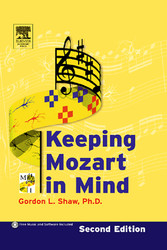Search and Find
Service
Front Cover
1
Keeping Mozart in Mind
4
Copyright Page
5
Contents
6
Foreword
10
Preface to the First Edition
12
Preface to the Second Edition
14
Acknowlegments
16
Prologue
20
Part I: Higher Brain Function: Music, Mathematics, Chess
28
Chapter 1. History, Anecdotes, Correlations, and Interviews
30
Chapter 2. Spatial-Temporal and Language-Analytic Reasoning in Learning Math and Science
44
Chapter 3. Music Enhances Spatial-Temporal Reasoning
56
Chapter 4. Implications: Scientific, Educational, Clinical
62
Part II: Structured Brain and Symmetry
68
Chapter 5. Symmetry as a Common Theme
70
Chapter 6. Introduction to the Brain: Basic Brain Features and Brain Imaging
80
Chapter 7. Mountcastle Theory of Mammalian Cortex: Internal Neural Language of Higher Brain Function
100
Chapter 8. Trion Model and Symmetries
114
Chapter 9. Trion Music: Reasoning and Creativity
148
Chapter 10. Trion Model of Higher Brain Function: Prediction that Music Enhances Spatial-Temporal Reasoning
168
Part III: Tests of Predictions in Human Behavior
172
Chapter 11. Highly Accurate Mental Rehearsals: Correlation with Top Performance in Sports
174
Chapter 12. Listening to Mozart Sonata (K.448) Enhances Spatial-Temporal Reasoning: The ‘‘Mozart Effect’’
186
Chapter 13. Music Training Enhances Spatial-Temporal Reasoning in Preschool Children
196
Chapter 14. Music Training Plus Spatial-Temporal Training Equals Improved Math
212
Part IV: Tests from Brain Imaging and Animal Studies
230
Chapter 15. EEG and fMRI Studies of the Mozart Effect
232
Chapter 16. Symmetry in Primate Higher Brain Function
238
Chapter 17. Musical Structure of the Internal Neural Language of the Brain: Using Music as the Rosetta Stone to Help Decode this Internal Language
256
Chapter 18. Animal Behavior While Listening to Music and Doing Higher Brain Functions
266
Part V: The Future of Music as a Window into Higher Brain Function
280
Chapter 19. Child Brain Development and Adult Brain Reorganization
282
Chapter 20. Education: Music Training Plus Spatial-Temporal Training Improves Math
296
Chapter 21. Clinical Implications
308
Chapter 22. The Spatial-Temporal Thinking Machine
322
Chapter 23. Thoughts
328
Part VI: New Scientific and Educational Results
350
Chapter 24. Science Updates and Breakthroughs
352
Chapter 25. Revolution in Math Education
368
Glossary
384
Notes
396
References
414
Index
428
All prices incl. VAT











